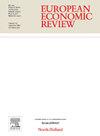关于严重物理灾害对GDP的影响
IF 2.4
2区 经济学
Q1 ECONOMICS
引用次数: 0
摘要
我们使用带有工具变量的本地预测方法来分析一个面板数据集,该数据集将与各种恶劣天气事件相关的货币损失和地球物理危害强度(作为我们的工具)联系起来。这种方法使我们能够在国家层面上了解这些事件对GDP的影响。估计的脉冲响应函数表明,在与灾害有关的货币损失增加后,GDP持续下降将持续数年。更严重的灾害对经济的负面影响更大。对于前10%的灾害,GDP在中期(5-7年)仍保持约2%的低水平,并且在我们分析的10年内不会完全恢复。当按灾害类型分类时,我们发现不同类别的结果相似,风暴成为主要驱动因素。高收入国家受到的影响明显小于中低收入国家。我们的研究结果适用于其他影响指标,如与灾害有关的死亡人数、受影响人数或简单的灾害发生指标。本文章由计算机程序翻译,如有差异,请以英文原文为准。
On the GDP effects of severe physical hazards
We use local projection methods with instrumental variables to analyze a panel dataset that links monetary damages and geophysical hazard strength (which serve as our instruments), associated with a wide range of severe weather events. This approach allows us to understand the GDP impact of these events at the country level. The estimated impulse response functions indicate a persistent GDP decline lasting several years after an increase in disaster-related monetary damages. More severe disasters leave a disproportionately larger negative effect on the economy. For the top 10 percent of disasters, GDP remains approximately 2 percent lower in the medium term (5-7 years) and does not fully recover over the 10-year horizon of our analysis. When disaggregating by disaster type, we find similar results across categories, with storms emerging as the primary driver. High-income countries experience significantly smaller effects than middle- and low-income countries. Our findings are robust to alternative impact measures, such as disaster-related deaths, the number of people affected, or a simple disaster occurrence indicator.
求助全文
通过发布文献求助,成功后即可免费获取论文全文。
去求助
来源期刊

European Economic Review
ECONOMICS-
CiteScore
4.70
自引率
3.60%
发文量
170
期刊介绍:
The European Economic Review (EER) started publishing in 1969 as the first research journal specifically aiming to contribute to the development and application of economics as a science in Europe. As a broad-based professional and international journal, the EER welcomes submissions of applied and theoretical research papers in all fields of economics. The aim of the EER is to contribute to the development of the science of economics and its applications, as well as to improve communication between academic researchers, teachers and policy makers across the European continent and beyond.
 求助内容:
求助内容: 应助结果提醒方式:
应助结果提醒方式:


